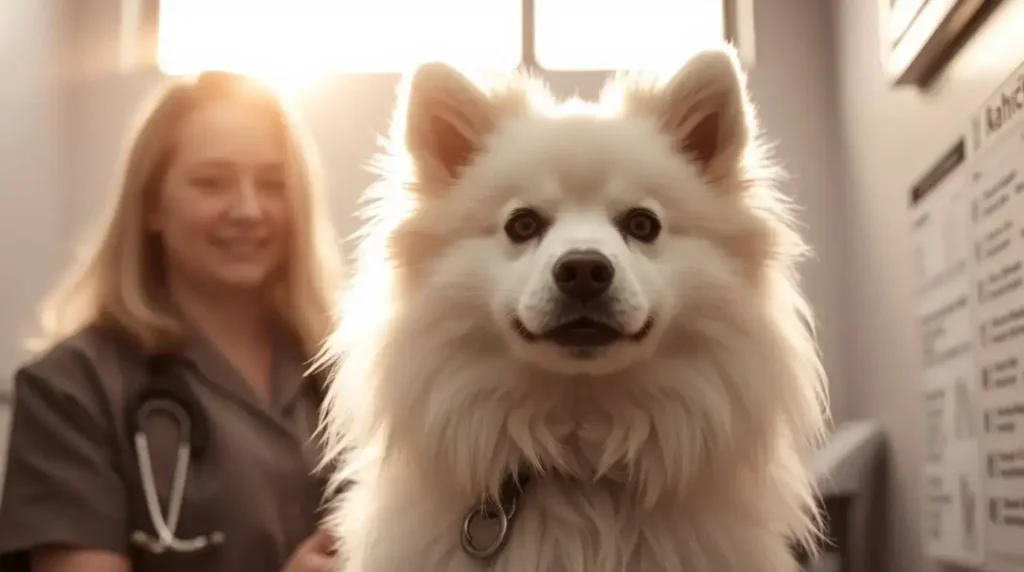At WhizPet, we believe informed pet parents raise healthier, happier dogs. That’s why we dug deep into veterinary studies, real-life case reports, and expert interviews to bring you a trusted breakdown of Health Issues in American Eskimo Dogs. Our research team spent weeks analyzing breed-specific health data, consulting professionals, and reviewing the most current findings to create this guide tailored for U.S. dog lovers.
If you’re an American Eskimo Dog owner or thinking of becoming one, this article is your go-to resource. Why? Because we don’t just scratch the surface—we uncover the Health Issues in American Eskimo Dogs that often go unnoticed until it’s too late. Our goal? To help you catch early signs, make smarter decisions, and give your Eskie the healthiest life possible.
So, let’s dive into the 7 most alarming Health Issues in American Eskimo Dogs—from genetic disorders to silent threats—and what you can do today to prevent them.

1. Hip Dysplasia: A Hidden Mobility Threat
Hip dysplasia is a common orthopedic condition among many dog breeds, including American Eskimos. It occurs when the hip joint doesn’t develop properly, leading to pain, arthritis, and eventual mobility issues. This is one of the health issues in American Eskimo Dogs that can severely affect their quality of life.
Symptoms:
- Limping or favoring one leg
- Difficulty getting up
- Decreased activity or reluctance to jump
Treatment Options:
- Weight management
- Physical therapy
- Anti-inflammatory medications
- Surgical options in severe cases
Expert Insight: Dr. Emily Rogers, DVM, says, “Early screening and regular check-ups can make a big difference in managing hip dysplasia in Eskies.”
2. Progressive Retinal Atrophy (PRA): Silent Vision Loss
Progressive Retinal Atrophy is a group of genetic eye diseases that leads to gradual vision loss and eventual blindness. Unfortunately, PRA shows no signs until it’s advanced. It’s a subtle but dangerous health issue in American Eskimo Dogs.
Warning Signs:
- Bumping into objects
- Night blindness
- Dilated pupils or cloudy eyes
Diagnosis & Treatment:
- Confirmed through an eye exam by a veterinary ophthalmologist
- No known cure, but antioxidant supplements may slow progression
Precaution Tip: Ask breeders for health certifications and genetic test results to ensure PRA-free lineage.
3. Diabetes Mellitus: A Rising Concern
Diabetes is becoming increasingly common in dogs, including American Eskimos. It affects the body’s ability to regulate blood sugar, leading to serious complications if untreated. Among all health issues in American Eskimo Dogs, this one demands lifelong management.
Signs to Watch For:
- Excessive thirst and urination
- Unexplained weight loss
- Lethargy and poor coat condition
Treatment & Management:
- Daily insulin injections
- Prescription diabetic dog food
- Regular blood glucose monitoring
According to a 2023 report by the American Veterinary Medical Association (AVMA), early diagnosis significantly improves long-term outcomes in diabetic dogs.
4. Luxating Patella: Slipping Kneecaps
Luxating patella is when the kneecap dislocates or “pops out” from its normal position. This issue is often genetic and can affect both front and back legs. It’s another example of common American Eskimo health problems to look out for.
Common Symptoms:
- Skipping or hopping on one leg
- Sudden yelps of pain
- Intermittent lameness
Treatment Options:
- Physical therapy
- Joint supplements
- Surgery in moderate to severe cases
Owner Experience: “Our Eskie had surgery at 3 years old, and she bounced back stronger than ever,” says dog owner Jane M., from Oregon.
5. Allergies: More Than Just an Itch
American Eskimo Dogs are prone to environmental and food allergies. These can manifest in skin irritations, digestive issues, and even chronic ear infections. Allergies are one of the less obvious but highly irritating health issues in American Eskimo Dogs.
Common Triggers:
- Pollen, mold, dust mites
- Chicken, beef, dairy
- Flea bites
Symptoms to Spot:
- Constant scratching or biting
- Red, inflamed skin
- Frequent ear infections
Treatment:
- Allergen-free diet
- Antihistamines or steroids
- Regular baths with medicated shampoos
Bonus Tip: Use a vet-approved flea prevention year-round.
6. Dental Disease: A Silent Threat
Dental disease is often overlooked but can lead to severe health issues like heart, kidney, or liver disease. Plaque buildup can be especially problematic in small to medium-sized breeds like Eskies. If left untreated, this can become one of the most damaging health issues in American Eskimo Dogs.
Signs of Trouble:
- Bad breath
- Yellow or brown teeth
- Swollen or bleeding gums
Prevention:
- Brushing your dog’s teeth daily
- Dental chews and toys
- Annual professional cleanings
Fact Check: According to the American Veterinary Dental Society, over 80% of dogs show signs of dental disease by age 3.
7. Hypothyroidism: The Underactive Thyroid Dilemma
Hypothyroidism occurs when the thyroid gland doesn’t produce enough hormones. It’s common in middle-aged Eskies and can slow down many of their bodily functions. It’s one of the more treatable yet often missed American Eskimo health problems.
Common Symptoms:
- Weight gain without increased appetite
- Hair thinning or skin infections
- Fatigue or depression-like behavior
Diagnosis:
- Blood tests to measure thyroid hormone levels
Treatment:
- Daily thyroid hormone replacement medication
- Regular blood monitoring
Life Expectancy Note: Proper management can allow Eskies with hypothyroidism to live a normal, healthy life.

Health Issues in American Eskimo Dogs: Prevention Tips
To minimize health issues in American Eskimo Dogs, follow these proactive steps:
- Choose a Reputable Breeder: Ask for genetic testing results and health certifications.
- Schedule Regular Vet Visits: Early detection is key to treating underlying health concerns.
- Maintain a Healthy Weight: Prevents joint stress, diabetes, and other weight-related diseases.
- Feed a Balanced Diet: Choose high-quality, breed-specific formulas with optimal nutrition.
- Exercise Daily: Keeps their body and mind in shape, reducing risk of multiple illnesses.
These small but consistent actions can significantly reduce the risk of health issues in American Eskimo Dogs. Prevention isn’t just about care—it’s about commitment, awareness, and building a healthy lifestyle for your Eskie.
FAQs About American Eskimo Dog Health
Q1. What is the average American Eskimo lifespan?
A: Typically 12–15 years, with good care and early management of health issues in American Eskimo Dogs.
Q2. Are American Eskimos prone to any genetic disorders?
A: Yes, including PRA, hip dysplasia, and luxating patella.
Q3. How can I tell if my Eskie has a health problem?
A: Watch for behavioral changes, limping, appetite loss, or skin issues.
Q4. What is the cost of treating common Eskie health problems?
A: Costs range from $100 (medications) to $3,000+ for surgeries like hip or knee corrections.
Q5. Can I see health issues in American Eskimo Dogs pictures?
A: Yes, visual signs like skin irritation or eye cloudiness are often visible. Always check with your veterinarian for an accurate diagnosis.
Final Thoughts: Take Action Today
Caring for an American Eskimo Dog means being vigilant about their health. These intelligent, affectionate dogs deserve the best care, and being informed is the first step. From understanding genetic risks to recognizing early symptoms, you now have the tools to protect your Eskie from the most alarming health issues in American Eskimo Dogs.
Take action now: Don’t wait until symptoms appear. Schedule a full health check-up with your vet to proactively manage health issues in American Eskimo Dogs.
Related blog: For more detailed information about pet care


Pingback: Can Raw diet for Dogs with Bladder Stones Naturally & Safely?